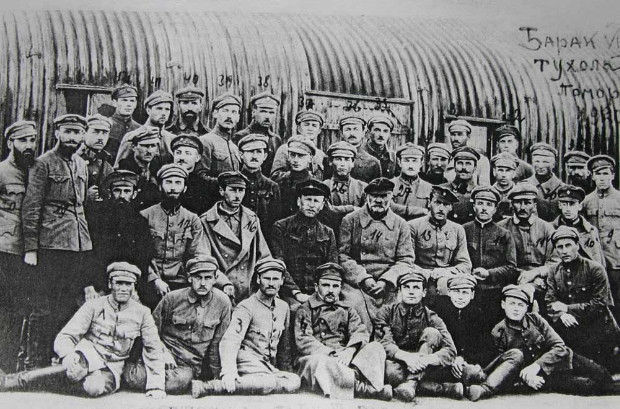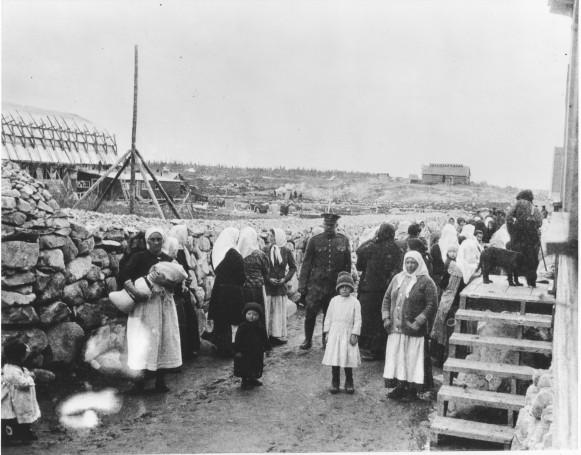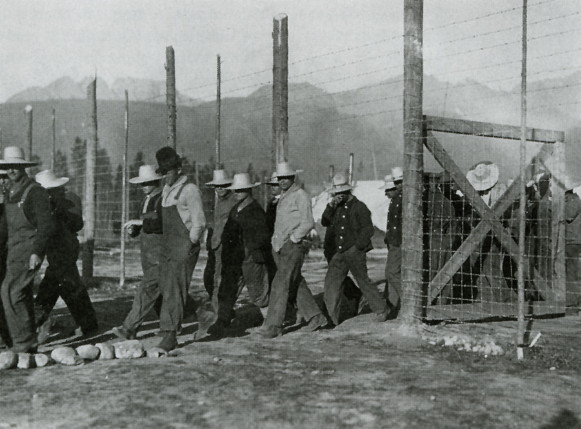Internment camps
Internment camps [табори інтернованих; tabory internovanykh]. Civilian internment camps were established in Canada during the First World War. Ukrainians formed the largest contingent of the nearly 6,000 interned as Austro-Hungarian nationals because they were considered to be potentially disloyal. Camps were established in Spirit Lake (Quebec), Petawawa and Kapuskasing (Ontario), Brandon (Manitoba), Banff and Jasper (Alberta), and Vernon (British Columbia). The Ukrainian internees were employed in building roads, erecting and repairing buildings, and cleaning and draining land.
In Poland, soldiers of the Army of the Ukrainian National Republic were first interned in Łańcut, in late 1919 following the collapse of the Ukrainian front, although some military units were organized from the internees and returned to central Ukraine to continue fighting the Red Army. After the final defeat of the UNR armies in November 1920, approximately 20,000 men crossed into Polish territory, where they were interned in several camps. The larger camps included those in Łańcut, Aleksandrów Kujawski, and Kalisz. Smaller camps were located at Tuchola, Wadowice, and Piotrków Trybunalski. In mid-1921, those interned at Łańcut were transferred to Strzałków, and in 1921, those at Aleksandrów Kujawski were transferred to Szczepiórno. The latter camp, as well as the neighboring one in Kalisz, remained open until August 1924.
Conditions in the internment camps in Poland were hard, but cultural and educational life in the camps was quite developed. Technical courses were provided for the illiterate; various schools were formed and a people’s university was established at Łańcut; choirs, theater groups, and other art and performance groups were active, as were religious organizations; and various publications were issued.
The administration of the camps was in Ukrainian hands. Officials of the Government-in-exile of the Ukrainian National Republic conducted officer training and instruction in military theory, and several veterans’ organizations were founded.
The internment camps in Kalisz and Szczepiórno were second to Warsaw as the largest centers of Ukrainian cultural life in Poland. The number of soldiers in these internment camps declined progressively. Many left for Czechoslovakia to study, and others went to France to work. After the closure of the camps, the veterans were given the status of political émigrés in Poland.
Following the end of hostilities, most remaining units of the Ukrainian Galician Army (UHA) made their way to Czechoslovakia, where they were interned. Sections of the Mountain Brigade of the Ukrainian Galician Army and the Sambir Brigade of the Ukrainian Galician Army and the Krukenychi Group were separated from the main forces of the UHA in May 1919 and forced to retreat into Transcarpathia, where they were disarmed and transferred to the camp at Deutsch-Gabel. The Czechoslovak authorities were sympathetic to the UHA soldiers and officers as long as the border disputes with Poland remained unresolved and they believed that the UHA could be used against the Poles. They issued full army rations and pay comparable to that of the Czechoslovak army, and granted all internees freedom of movement. Passes to Prague could be obtained on producing Ukrainian Army identification. General Antin Kravs’s group was interned at Liberec on 10 September 1920, after it had left the Dnister River front and crossed Transcarpathia with 300 officers and 500 men. They were joined by another 130 officers and men who arrived from the Italian prisoner of war camp at Monte Cassino. In April 1921 the 4,000 internees from Liberec and Deutsch-Gabel were transferred to Josefov. The camp there remained operative until 1926.
The number of soldiers in internment camps began to decrease in 1921, when the government formed workers’ brigades (70 such brigades were formed in various towns throughout Czechoslovakia in 1921). Some returned to Galicia after 1923 when it was ceded to Poland by international agreement. Most officers traveled to study in Prague, Poděbrady (at the Ukrainian Husbandry Academy), Brno, and Příbram. After the closure of the Josefov camp, veterans were granted political immigrant status and some took Czechoslovak citizenship. Various military training programs, technical courses, literacy programs, general higher education courses, as well as general social and cultural activity such as choirs, libraries, publishing concerns, and theater groups, all formed part of the life in the internment camps.
BIBLIOGRAPHY
Narizhnyi, S. Ukraïns’ka emigratsiia (Prague 1942)
Motyl, A.J. The Turn to the Right: The Ideological Origins and Development of Ukrainian Nationalism 1919–1929 (Boulder, Colo 1980)
Melnycky, P. ‘The Internment of Ukrainians in Canada,’ in Loyalties in Conflict: Ukrainians in Canada during the Great War, eds F. Swyripa and J.H. Thompson (Edmonton 1983)
Kordan, Bohdan S. and Peter Melnycky (eds.) In the Shadow of the Rockies: Diary of the Castle Mountain Internment Camp, 1915–1917 (Edmonton 1991)
Sribniak, Ihor. Obezzbroiena, ale neskorena: Internovana Armiia UNR u taborakh Pol'shchi i Rumuniï (1921–1924) (Kyiv and Philadelphia 1997) http://elibrary.kubg.edu.ua/id/eprint/19901/
Karpus, Z.; W. Rezmer. Tuchola: Obóz jeńców i internowanych (1914–1923) (Toruń 1997)
———. Tuchola: Obóz jeńców i internowanych (1914–1923). Choroby zakaźne i walka z nimi (Toruń 1998)
Sribniak, Ihor. Poloneni ukraїntsi v Avstro-Uhorshchyni ta Nimechchyni (1914–1920 rr.) (Kyiv 1999)
———. Ukraїntsi na chuzhyni: Poloneni ta internovani voiaky-ukraїntsi v kraїnakh Tsentral'noï ta Pivdenno-Skhidnoї Ievropy (1919–1924 rr.): Stanovyshche, orhanizatsiia, kul'turno-prosvitnyts'ka diial'nist' (Kyiv 2000)
Karpus, Z.; W. Rezmer; I. Sribniak; E. Wiszka. Tuchola (1914–1923): Warunki życia jeńców i internowanych (Toruń 2007)
Wiszka, Emilian. Aleksandrów Kujawski (1918–1921): Warunki życia jeńców i internowanych oraz ukraińskiej emigracji politycznej (Toruń 2008)
———. Brześć Litewski: Obozy jeńców i internowanych (1919–1921) (Toruń 2010)
Sribniak, Ihor. Entsylopediia polonu: Ukraїnska Tuchola (Kyiv and Paris 2017) http://elibrary.kubg.edu.ua/id/eprint/18844/
Yuri Boshyk, Lev Shankovsky
[This article originally appeared in the Encyclopedia of Ukraine, vol. 2 (1988).]



.jpg)
